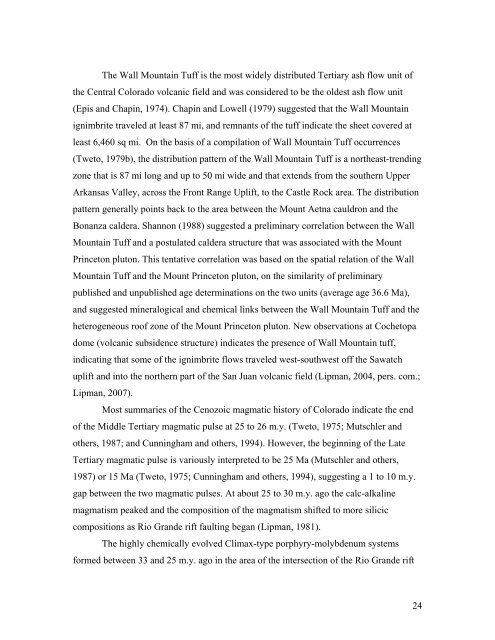Geologic Map of the Maysville Quadrangle, Chaffee County, Colorado
Geologic Map of the Maysville Quadrangle, Chaffee County, Colorado
Geologic Map of the Maysville Quadrangle, Chaffee County, Colorado
You also want an ePaper? Increase the reach of your titles
YUMPU automatically turns print PDFs into web optimized ePapers that Google loves.
The Wall Mountain Tuff is <strong>the</strong> most widely distributed Tertiary ash flow unit <strong>of</strong><br />
<strong>the</strong> Central <strong>Colorado</strong> volcanic field and was considered to be <strong>the</strong> oldest ash flow unit<br />
(Epis and Chapin, 1974). Chapin and Lowell (1979) suggested that <strong>the</strong> Wall Mountain<br />
ignimbrite traveled at least 87 mi, and remnants <strong>of</strong> <strong>the</strong> tuff indicate <strong>the</strong> sheet covered at<br />
least 6,460 sq mi. On <strong>the</strong> basis <strong>of</strong> a compilation <strong>of</strong> Wall Mountain Tuff occurrences<br />
(Tweto, 1979b), <strong>the</strong> distribution pattern <strong>of</strong> <strong>the</strong> Wall Mountain Tuff is a nor<strong>the</strong>ast-trending<br />
zone that is 87 mi long and up to 50 mi wide and that extends from <strong>the</strong> sou<strong>the</strong>rn Upper<br />
Arkansas Valley, across <strong>the</strong> Front Range Uplift, to <strong>the</strong> Castle Rock area. The distribution<br />
pattern generally points back to <strong>the</strong> area between <strong>the</strong> Mount Aetna cauldron and <strong>the</strong><br />
Bonanza caldera. Shannon (1988) suggested a preliminary correlation between <strong>the</strong> Wall<br />
Mountain Tuff and a postulated caldera structure that was associated with <strong>the</strong> Mount<br />
Princeton pluton. This tentative correlation was based on <strong>the</strong> spatial relation <strong>of</strong> <strong>the</strong> Wall<br />
Mountain Tuff and <strong>the</strong> Mount Princeton pluton, on <strong>the</strong> similarity <strong>of</strong> preliminary<br />
published and unpublished age determinations on <strong>the</strong> two units (average age 36.6 Ma),<br />
and suggested mineralogical and chemical links between <strong>the</strong> Wall Mountain Tuff and <strong>the</strong><br />
heterogeneous ro<strong>of</strong> zone <strong>of</strong> <strong>the</strong> Mount Princeton pluton. New observations at Cochetopa<br />
dome (volcanic subsidence structure) indicates <strong>the</strong> presence <strong>of</strong> Wall Mountain tuff,<br />
indicating that some <strong>of</strong> <strong>the</strong> ignimbrite flows traveled west-southwest <strong>of</strong>f <strong>the</strong> Sawatch<br />
uplift and into <strong>the</strong> nor<strong>the</strong>rn part <strong>of</strong> <strong>the</strong> San Juan volcanic field (Lipman, 2004, pers. com.;<br />
Lipman, 2007).<br />
Most summaries <strong>of</strong> <strong>the</strong> Cenozoic magmatic history <strong>of</strong> <strong>Colorado</strong> indicate <strong>the</strong> end<br />
<strong>of</strong> <strong>the</strong> Middle Tertiary magmatic pulse at 25 to 26 m.y. (Tweto, 1975; Mutschler and<br />
o<strong>the</strong>rs, 1987; and Cunningham and o<strong>the</strong>rs, 1994). However, <strong>the</strong> beginning <strong>of</strong> <strong>the</strong> Late<br />
Tertiary magmatic pulse is variously interpreted to be 25 Ma (Mutschler and o<strong>the</strong>rs,<br />
1987) or 15 Ma (Tweto, 1975; Cunningham and o<strong>the</strong>rs, 1994), suggesting a 1 to 10 m.y.<br />
gap between <strong>the</strong> two magmatic pulses. At about 25 to 30 m.y. ago <strong>the</strong> calc-alkaline<br />
magmatism peaked and <strong>the</strong> composition <strong>of</strong> <strong>the</strong> magmatism shifted to more silicic<br />
compositions as Rio Grande rift faulting began (Lipman, 1981).<br />
The highly chemically evolved Climax-type porphyry-molybdenum systems<br />
formed between 33 and 25 m.y. ago in <strong>the</strong> area <strong>of</strong> <strong>the</strong> intersection <strong>of</strong> <strong>the</strong> Rio Grande rift<br />
24




